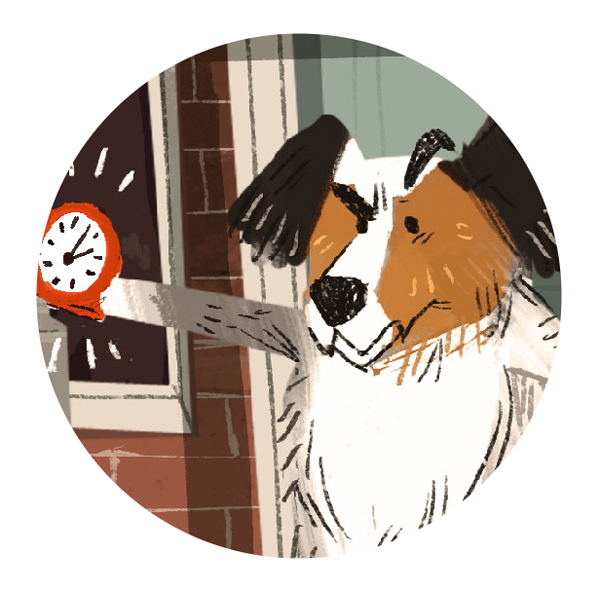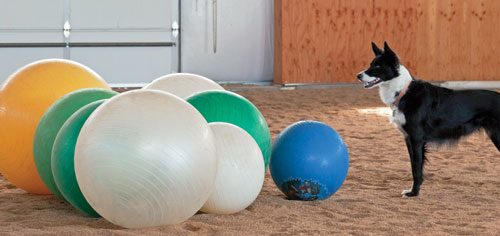

Can Dogs Tell Time?
Inquiring minds want to know!
I awaken to a cold nose against my hand. It is my 14-year-old Nova Scotia Duck Tolling Retriever, Dancer. Perhaps because of his age, he is more fixed in his daily routine than any of my other dogs. I glance at the alarm clock and mutter to him, “You’re an hour too early, old boy” before turning over to try to go back to sleep.
10 a.m finds Dancer is pacing by the door. Our postman starts his route with my corner house each morning at 11 a.m. Dancer usually stands by the door about five minutes before he arrives so that he can bark to announce the arrival of the mail. I am wondering why my dog’s clock-like precision is off kilter today when I suddenly remember that we have just shifted out of daylight savings time; all of our clocks—at least our human clocks—have been moved backward by an hour. Dancer is obviously still operating on daylight savings time.

Dogs have a good circadian clock—as most of us can no doubt attest, they definitely know when dinner is supposed to be. Proving this is one of Pavlov’s famous conditioned reflex experiments. It involved spraying meat powder into the mouths of a group of dogs at noon every day for two weeks in a row and carefully monitoring the flow of saliva it produced. Then, on the 15th day, no meat powder was sprayed, yet the dogs still salivated almost exactly at noon.
Circadian clocks depend on a lot of different things. To begin with, there are hormonal levels which fluctuate with an approximately 24 hour cycle and these changes in chemical levels could serve as a signal for the passage of time. Another indicator of the passage of time is that light levels increase and decrease over the day. However, just as important are the changes in activity during the day. Traffic noises outside fluctuate as we reach rush hour and activities inside the house, such as the family rising, washing, preparing food, and so on, also signal significant times during the day. I know, for example, that Dancer will adjust his circadian clock to match those of the humans in his family over the next few days simply by observing the flow of activities in my house.
There are other forms of time perception, however. One of the most common is the perception of duration, which is simply how much time has passed since a particular event has happened. Dogs are pretty good at this as can be confirmed by nearly everybody who has trained dogs for obedience competition. For example, in the Open Level of competition the dog must hold a sitting or down position for a period of three minutes. Many inexperienced dog trainers train their dogs to stay in position for exactly three minutes, partly because this seems adequate for the task and partly because standing 40 feet away from your dog while both of you do nothing is rather boring. This is a bad move, though, since in actual competition judges and ring stewards are not always precise and events having to do with moving the competitors into or out of the obedience ring can take a bit longer than expected. As a result, the dog handler may find that at the very last moment, before he gets to his dog’s side, the canine duration clock times out and the dog stands up, ending that round with a disqualification. That is why most knowledgeable dog trainers over-time their dogs, keeping them in their sit-stay or down-stay for four or five minutes, thus leaving the dog’s clock still ticking if things go slowly in competition.
Dogs can learn quite precise durations. Psychologists have what is called a “delayed response test” to test this aspect of time perception in dogs. The way a typical test occurs is that dogs are given a signal, say a click or a light flash, and then they must wait for a fixed interval of time before they perform a task, such as jumping onto a platform or pressing a bar. In one study by Belgian researchers, Beagles were trained to wait exactly 90 seconds between a sound signal and their response to it. If they responded too early they were not rewarded, and if they responded more than a few seconds too late they also did not get the treat that they were seeking. The food-motivated Beagles tuned their duration clocks quite finely to accomplish this task.
Although dogs can tell the difference between a short time and a long time, they are not so good at discriminating between long times and even longer times.
When it comes to perceiving the passage of time, though, it turns out that although dogs can tell the difference between a short time and a long time, they are not so good at discriminating between long times and even longer times. An example of this comes from some research by Therese Rehn and Lindsay Keeling at the Swedish University of Agricultural Sciences in Uppsala. They were interested in the issue of separation anxiety in dogs since many dogs are left at home while their owners go to work each day and there had been some suggestions that the longer the dog is left alone, the more anxious it becomes. These researchers recorded the behaviour of dogs left by their owners for 30 minutes, two hours or four hours. The results showed that if the dogs had been left alone for two or four hours they greeted their owners with more excitement (as measured physiologically) and also were more active and affectionate in their behaviour, than when the duration of separation had only been 30 minutes. However, there was no statistical difference between the dogs’ behaviour if left alone for two or four hours. The researchers concluded the dogs were aware of the difference between the short time duration and the longer ones, but could not discriminate between the longer time intervals.
Although this research suggests that dogs’ duration perception is far from perfect, they are probably the only animal whose accurate circadian clock has earned them a monument. Hachiko was an Akita owned by Dr. Eisaburo Ueno, a professor at Tokyo University. Every day Hachiko would accompany his master to the train station to see him off. Hachiko’s internal circadian clock triggered his return to the station each day at precisely three o’clock in the afternoon to greet his master. On May 21, 1925, Professor Ueno did not return; he had died earlier that day at the university. His loyal Akita, however, arrived on time and waited at the station until midnight. The next day and for the next ten years, Hachiko returned to the station at exactly three o’clock and waited for his beloved master before walking home alone. Nothing and no one could discourage Hachiko from maintaining his daily vigil. It was not until Hachiko himself died in March l934 that he failed to appear at the railroad station at the scheduled time. A statue in honour of the devoted Akita was erected near the Shibuya Station. It was destroyed during the war, but replaced in 1948, sculpted to be an exact replica by the son of the artist who had produced original statue. This train station is now a place where lovers go to touch the statue of the dog and to pledge that they will be as faithful to each other as Hachiko was to his master, although it’s doubtful they also promise to keep as accurate time as this dog did.
Join the newsletter and never miss out on dog content again!
"*" indicates required fields
By clicking the arrow, you agree to our web Terms of Use and Privacy & Cookie Policy. Easy unsubscribe links are provided in every email.





